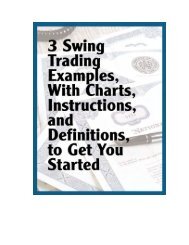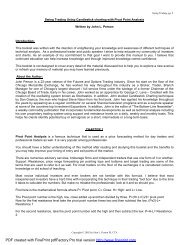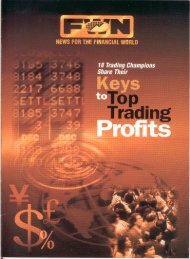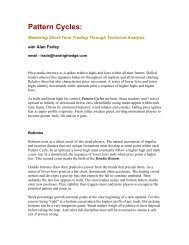To all those who did not dedicate - The Swing Trading Guide
To all those who did not dedicate - The Swing Trading Guide
To all those who did not dedicate - The Swing Trading Guide
Create successful ePaper yourself
Turn your PDF publications into a flip-book with our unique Google optimized e-Paper software.
A Practical <strong>Guide</strong> to <strong>Swing</strong> <strong>Trading</strong> by Larry <strong>Swing</strong><br />
of the stock you are using as collateral goes down in price, so that your collateral is<br />
less than the "maintenance" requirement (usu<strong>all</strong>y 30% of the value of the short<br />
position) you will be required to add money to your margin account or buy back the<br />
stock that you sold short. You must also pay any dividends issued by the company<br />
<strong>who</strong>se stock you sold short.<br />
12.1.4 Up Tick Rule<br />
<strong>To</strong> sell your stock short, you must adhere to the up-tick rule. <strong>The</strong> transaction before<br />
your short sale must have been executed at a higher price than the transaction<br />
before it. In other words, the transaction before your short sale must be an up-tick.<br />
In practice, you can<strong>not</strong> short a stock that is already f<strong>all</strong>ing in price. Otherwise, short<br />
selling would amplify the decline.<br />
12.1.5 Why Sell Short?<br />
<strong>The</strong> two primary reasons for selling short are opportunism and portfolio protection.<br />
Occasion<strong>all</strong>y investors see a stock that they believe has been hyped to a ridiculously<br />
high level. <strong>The</strong>y believe that the stock price will f<strong>all</strong> when reality replaces the hype. A<br />
short sale provides the opportunity to profit from the overpriced stock. Short sales<br />
are also used to protect an investor's portfolio against a market downturn. By<br />
shorting stocks that the investor believes will f<strong>all</strong> sharply when the market as a<br />
<strong>who</strong>le f<strong>all</strong>s, investors can help insulate the value of their portfolios against sudden<br />
market drops.<br />
Zitel provides an example of opportunistic short selling. In 1996, Zitel was caught up<br />
in a wave of investor enthusiasm because it has a stake in a company that fixes the<br />
computer glitch that causes computers to interpret dates in the next century (2000s)<br />
as dates in this century (1900s). This problem, known as the "Year 2000" problem,<br />
suddenly became a hot topic of conversation and made it to the covers of Time and<br />
Newsweek. In September 1996, Zitel was selling for $7 per share. By December, the<br />
shares topped $70. At this point, many investors thought the stock was overpriced<br />
and saw an opportunity to make money by selling it short. If an investor had sold<br />
short in December 1996, he could have bought the stock back for $15 per share in<br />
April 1997. Selling short would have <strong>all</strong>owed the investor to take very profitable<br />
advantage of the opportunity presented by the overpriced Zitel stock.<br />
Visit: http://www.mrswing.com/ or email: larry@mrswing.com












